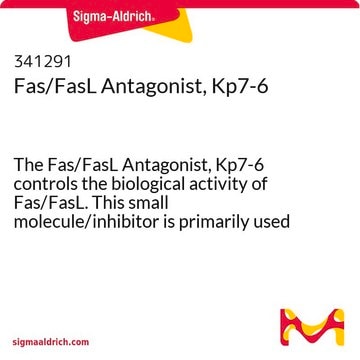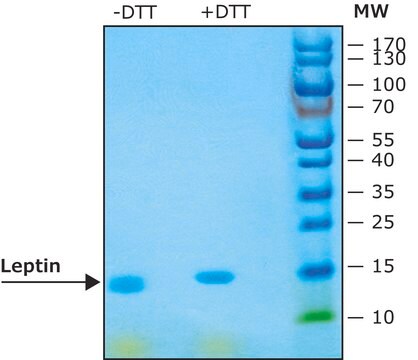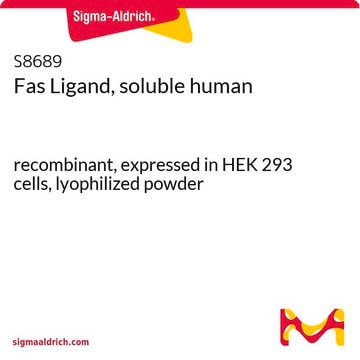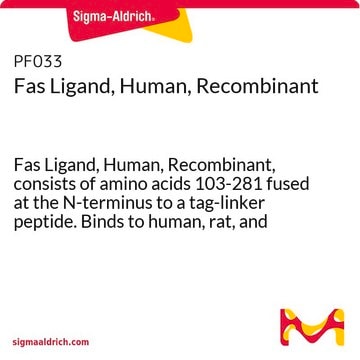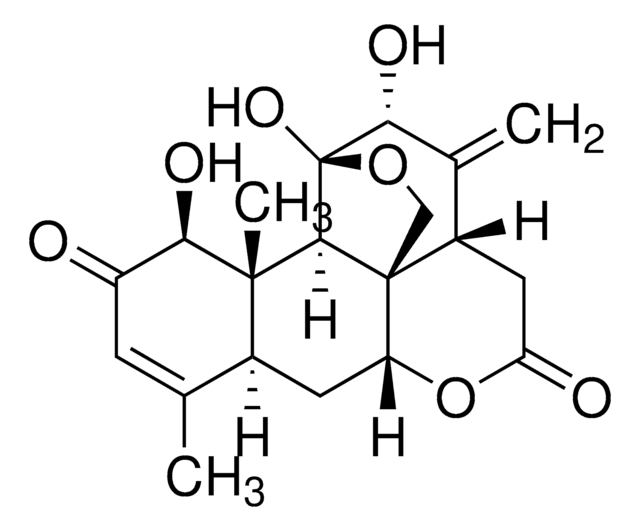추천 제품
재조합
expressed in mouse NSO cells
Quality Level
분석
>95% (SDS-PAGE)
형태
lyophilized powder
분자량
monomer calculated mol wt ~18 kDa
28-32 kDa by SDS-PAGE
불순물
endotoxin, tested
UniProt 수납 번호
저장 온도
−20°C
유전자 정보
mouse ... Fasl(14103)
일반 설명
FASLG (Fas ligand) acts as a ligand for Fas receptor, and is a major protein involved in programmed cell death, apoptosis. Soluble Fas (sFAS) is usually detected in plasma prior to apoptosis.
애플리케이션
Fas Ligand (FASLG) from mouse has been used for-
- the induction of apoptosis in PC12 cells and
- the induction of migration in BV-2 murine microglial cells.
생화학적/생리학적 작용
FASLG (Fas ligand) and Fas receptor constitute the basic elements in apoptosis. Interaction of FASLG with Fas receptor leads to activation of caspase-8. This caspase in turn leads to activation of effector caspases such as caspase-3, -6 and -7. This cascade results in the hydrolysis of nuclear and cytoplasmic components. Expression of FASLG is induced by nuclear factor-κB (NFκB). NFκB/FASLG pathway facilitates the suppression of p,p′-DDT (dichlorodiphenoxytrichloroethane)-induced cell toxicity by vitamin C and E. In CD4+ T cells, this protein is expressed on stimulus by T-cell receptor (TCR), both during normal and pathological conditions, such as alcohol exposure.
Fas ligand, a protein belonging to the tumor necrosis factor (TNF) family of cytokines, induces apoptosis in cells expressing the cell membrane receptor Fas (CD95/Apo-1).
기타 정보
Mouse Fas Ligand, N-terminal 6X histidine-tagged, encodes amino acid residues 132-279.
물리적 형태
Lyophilized from a 0.2 μm filtered solution in phosphate buffered saline containing 2.5 mg bovine serum albumin.
분석 메모
Measured by its ability to induce apoptosis in Jurkat cells.
Storage Class Code
10 - Combustible liquids
WGK
WGK 3
Flash Point (°F)
Not applicable
Flash Point (°C)
Not applicable
시험 성적서(COA)
제품의 로트/배치 번호를 입력하여 시험 성적서(COA)을 검색하십시오. 로트 및 배치 번호는 제품 라벨에 있는 ‘로트’ 또는 ‘배치’라는 용어 뒤에서 찾을 수 있습니다.
Aleksander Szymanowski et al.
Atherosclerosis, 233(2), 616-622 (2014-02-19)
Apoptosis of natural killer (NK) cells is increased in patients with coronary artery disease (CAD) and may explain why NK cell levels are altered in these patients. Soluble forms of Fas and Fas ligand (L) are considered as markers of
Xiaoting Jin et al.
PloS one, 9(12), e113257-e113257 (2014-12-03)
Dichlorodiphenoxytrichloroethane (DDT) is a known persistent organic pollutant and liver damage toxicant. However, there has been little emphasis on the mechanism underlying liver damage toxicity of DDT and the relevant effective inhibitors. Hence, the present study was conducted to explore
Ying-mei Lu et al.
Journal of neuroinflammation, 9, 172-172 (2012-07-14)
The cerebral microvascular occlusion elicits microvascular injury which mimics the different degrees of stroke severity observed in patients, but the mechanisms underlying these embolic injuries are far from understood. The Fas ligand (FasL)-Fas system has been implicated in a number
Nicole Suyun Liu et al.
PloS one, 7(8), e43180-e43180 (2012-08-21)
Diva is a member of the Bcl2 family but its function in apoptosis remains largely unclear because of its specific expression found within limited adult tissues. Previous overexpression studies done on various cell lines yielded conflicting conclusions pertaining to its
Smita S Ghare et al.
Journal of immunology (Baltimore, Md. : 1950), 193(1), 412-421 (2014-06-06)
Activation-induced Fas ligand (FasL) mRNA expression in CD4+ T cells is mainly controlled at transcriptional initiation. To elucidate the epigenetic mechanisms regulating physiologic and pathologic FasL transcription, TCR stimulation-responsive promoter histone modifications in normal and alcohol-exposed primary human CD4+ T
자사의 과학자팀은 생명 과학, 재료 과학, 화학 합성, 크로마토그래피, 분석 및 기타 많은 영역을 포함한 모든 과학 분야에 경험이 있습니다..
고객지원팀으로 연락바랍니다.
